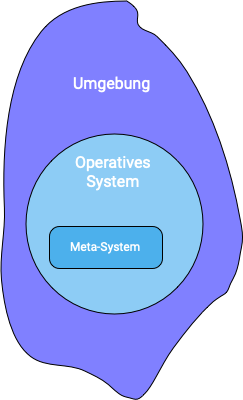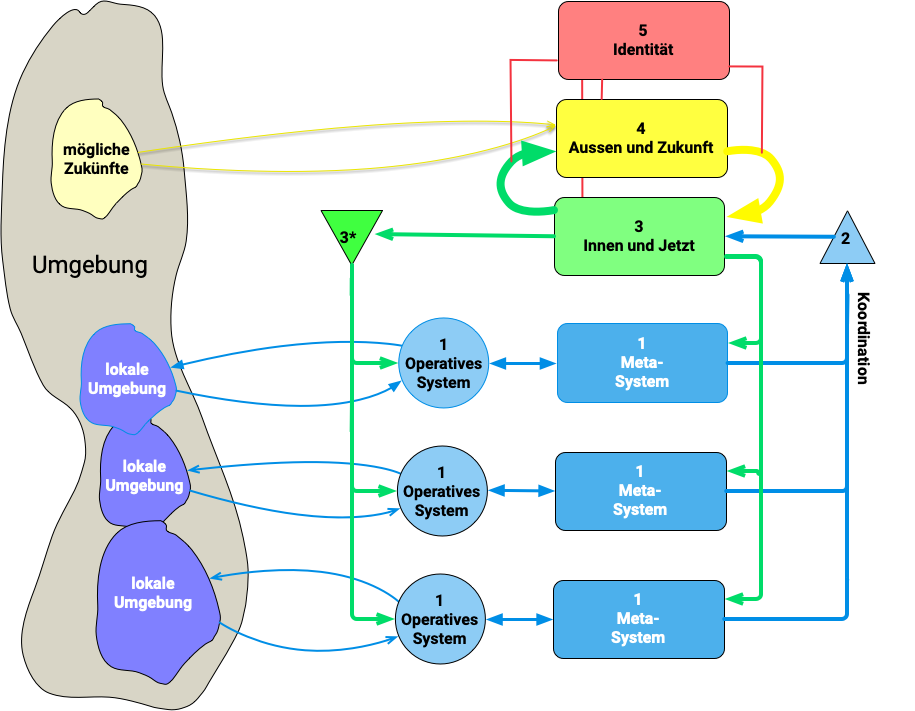Eight Advantages of the Viable System Model
Das Viable System Model hilft bei Analyse und Design von Organisationsstrukturen, insbesondere Entscheidungen und Kommunikation. Das VSM implementiert organisatorische Kybernetik.
In the complex and dynamic landscape in which organizations operate today, a robust and adaptable management approach that can effectively deal with the challenges and uncertainties of the modern business environment is crucial.
Choosing the right approach is not getting any easier. Lean is already a widely accepted standard, and agility is increasingly becoming a commodity. It also doesn’t help if the HR department and the business units squabble over the interpretation of organizational development. In order to develop new competitive advantages, we believe that a more holistic approach must be used, one that considers
- all parts of the company are considered, i.e. not only development but also the operational units and supporting areas such as marketing or HR.
- design all dimensions of the company in an integrated manner, i.e. not only processes and structures but also decisions and communication as well as people, skills and motivations.
- to derive comprehensible diagnoses of dysfunctionalities in the organization and to derive options for improvement from them.
- the granularity of the units under consideration can be freely selected and it is possible to design gradual improvements or far-reaching transformations for these units.
The VSM in a nutshell
One such model that has received recognition and praise for its ability to improve organizational sustainability and viability is the Viable System Model (VSM). Developed by Stafford Beer, the VSM provides a comprehensive framework that enables organizations to understand and optimize their internal processes. In this article, we will explore the benefits of the Viable System Model (VSM) and why it has become a valuable tool for modern management.
The term “viable” encompasses not only the ability to survive but also to maintain its own direction or identity. By taking an integrated view of the environment (or business ecosystem), the term “viable” becomes synonymous with “sustainable”.
A first consideration would be the following diagram:

The elements in this are
- The environment, e.g. customers, competition or government regulations
- The operational system as the determining view (“the system is what it does” — Stafford Beer)
- The metasystem or the local organization. It means preferably self-organization, as far as this is possible, but in principle includes any kind of organization.
It also shows the relationships
- between the environment and the operative system, as two directed communication channels
- between the operative system and the meta-system, also as two communication channels.
For a clearer representation of the relationships, this picture is usually drawn apart:

In order to complete the analysis, further aspects must be added and the communication channels planned, i.e.
- Coordination between parallel units (2). This includes such diverse things as secretariat, standards of conduct
- The stabilizing aspects (3, in VSM-speak: “inwards and now”) such as controlling, compliance, marketing, which ensure an effective and stable organization
- The future-oriented aspects (4, in VSM-speak “outward and future”), which help the organization to prepare for future challenges
- The preservation of identity (5), which moderates between the conflicting requirements of the aforementioned aspects and keeps an eye on the overall system.

The benefits of VSM
1. holistic systems thinking
One of the main advantages of the Viable System Model is its holistic approach to understanding organizations. The model emphasizes the interdependencies and interactions between the various components of a system and views the organization as a complex adaptive system. By analyzing the organization as a whole in its environment, rather than focusing only on individual parts, the VSM enables managers to gain a comprehensive perspective and make informed decisions that take into account the entire ecosystem of the organization.
2. increased organizational resilience
The core principle of VSM is the concept of viability, which refers to an organization’s ability to adapt and survive in a changing environment. The model helps organizations identify potential vulnerabilities and inefficiencies within their structure so that they can build their resilience and improve their ability to respond effectively to external disruptions. By improving adaptability and flexibility, the VSM enables organizations to manage uncertainty and maintain their viability in the face of constant change.
3. clear communication and coordination
One of the fundamental features of the Viable System Model is its emphasis on effective communication and coordination within an organization. The model defines different organizational units or systems, each with specific functions and responsibilities. These units operate autonomously but are also linked together through feedback loops to ensure an effective flow of information and coordination. This structured approach facilitates transparent communication, reduces silos and enables rapid decision-making within the organization.
4. improved decision making:
The Viable System Model provides a valuable framework for decision making at various levels of an organization. The model encourages managers to analyze data, information flows and feedback mechanisms so that they can make informed decisions based on the current state of the system. By looking at the entire system and its interdependencies, decision makers can identify potential bottlenecks, anticipate future challenges and implement effective solutions that align with the organization’s strategic goals.
5. effective organizational design:
With its focus on an organization’s internal structure and functions, the Viable System Model helps design efficient organizational structures. By identifying key systems and subsystems and their roles and responsibilities, the model helps organizations optimize their processes and allocate resources. This ensures that the organization is well equipped to manage tasks, adapt to change and align its functions to achieve its goals.
6. continuous learning and adaptation:
The Viable System Model promotes a culture of continuous learning and adaptation within an organization. By emphasizing feedback loops and information sharing, the model encourages organizations to monitor their performance, identify areas for improvement and implement necessary changes. This iterative approach allows organizations to evolve and improve their viability over time by adapting to new market conditions, customer demands and technological advances.
7. the VSM is fractal
The VSM can be applied to different levels – this does not mean the same as hierarchy, but levels of abstraction. In addition to the system itself, the relationships to the embedded systems and also the relationships to the next higher abstraction level are analyzed or modeled for this selected abstraction level (VSM-speak: “system in focus”).
Together with the choice of the intensity of the intervention, it is possible to control very precisely how large the “blast radius” of a measure will be. This is an important advantage for risk management in a change process.
8. combination with existing methods
The VSM adds an additional view of the organization, namely the view of decision-making and communication processes. It draws from its cybernetic roots powerful conceptual tools that make improvement opportunities comprehensible. These tools help to identify blind spots without claiming to overturn all existing structures
Summary
In an era characterized by rapid change and complexity, organizations need effective management models that promote resilience, adaptability and efficient decision-making. The Viable System Model provides a comprehensive framework that meets these needs by providing a holistic view of organizations, improving coordination and communication, streamlining decision-making processes, enabling effective organizational design, and fostering a culture of continuous learning. By embracing the benefits of the VSM, organizations can position themselves to thrive in the face of uncertainty and ensure their long-term viability.